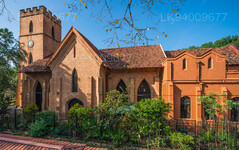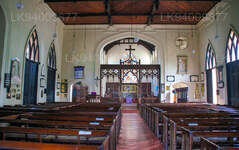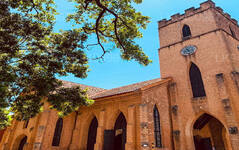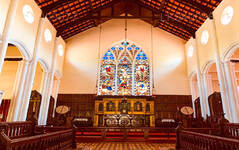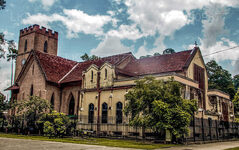
Kandy-stad
Kandy, een pittoreske stad in centraal Sri Lanka, staat bekend om zijn rijke culturele erfgoed, levendige festivals en schilderachtige schoonheid. Gelegen tussen weelderige heuvels, herbergt de stad de Tempel van de Tand, een UNESCO-werelderfgoed, en biedt een fascinerende mix van geschiedenis en natuurlijke pracht.
St Pauls Church
St Paul’s Church is an Anglican Church located in an area called Milagiriya in Colombo 04, Sri Lanka. It has its origins in the Portuguese era of the 16th century. Today it is one of the oldest and most historic churches within Colombo and is also well known due to the attached girls’ school. Here’s the story of how it came to be:
The Early Portuguese Church
Over four centuries ago, when the Portuguese invaded Sri Lanka – they caused mass destruction to the local religions and built Roman Catholic Churches to spread their discipline of Christianity. It is unknown why they chose to build a church at that specific location, but perhaps there may have been some sort of locally popular shrine there that they destroyed and built over – as was their habit.
The newly built church, at the time, was known as ‘Nossa Senhora dos Milagres’ or ‘Our Lady of Miracles’. The locals, due to their lack of knowledge and understanding about the Portuguese language, took to calling the church ‘Milagres’, which is actuality meant ‘Miracles’. With time the name evolved, and the entire area surrounding the church came to be known as ‘Milagiriya’.
The British Takeover
However, the ‘Church of Miracles’ did not last. Approximately a century later, Ceylon was invaded by the Dutch who suppressed the Portuguese and wrested control of the valuable trade route island from them. To consolidate their rule, the Dutch thoroughly destroyed all Portuguese monuments and churches that they could find. Nossa Senhora dos Milagres was one of these churches that fell under their hands. The consecrated land remained bare for over a century, until the British decided to invade and took control of Sri Lanka from the Dutch.
The Building of St Paul’s
In the 1840s, a large number of Anglican churches started to get constructed. The premise behind them was mainly to give places of worship for British countrymen, but also to persuade the native population to change their religion and follow the Anglican discipline.
St Paul’s Anglican Church, which was built over the ruins of the old Portuguese church in Milagiriya, was one such church built by the British. The construction of the church began in 1948 under the initiation of the British cleric, Reverend Joseph Thurston, who dedicated it to St Paul. It was completed in 1953 and consecrated by the Bishop of Colombo at the time. An attached industrial school was also built at the same time to give a place of learning for Anglican youth. However, the main attraction was the font within the church grounds, hailing from the time of the previous Portuguese church. Its water was said to have miraculous healing properties, and sick people from all over the country visited the church to experience this healing.
Between the 1890s to the early 1900s, the church flourished and many locals joined the congregation as well. This was also partly due to the efforts of the first two vicars, Rev. John Ford and Rev. Harry Marsh ,who worked within the neighborhood to help the natives at their times of need.
A Change in Leadership
In the early 1900s, with the arrival of the First World War, the British began losing interest in Sri Lanka. Many Englishmen and other Europeans left the island, returning to their home countries or moving to the newly settled land of Australia. The leadership of St Paul’s fell into the hands of the elite and influential members of the congregation, and the very first native Sri Lankan Vicar for the church was elected in 1920. Rev. Paul Lucien Jansz took up official duties as the third vicar of St. Paul’s, and continued till 1953.
In the meantime, the Second World War occurred in the 1940s and the British lost much of their troops. It spelled the death knell to Britian’s supremacy over the countries in the East and Far East. They gave independence to most of those countries that they had established a rule over, and returned back to England or went to Australia. By the 1950s and 1960, when Rev Jansz ended his term as the vicar of St Paul’s, there were little to no British clergy left to take over the office and the vicarage continued to be passed over to Sri Lankans – fulling transferring the leadership to native hands.
The Church as it is Today
Today St. Paul’s Church in Milagiriya comes under the Church of Ceylon, the main Anglican Church in Sri Lanka, and is part of the diocese of the Archbishop of Canterbury. The vicars throughout the years continued to grow and develop the church, making it extremely popular amongst the Colombo population. Today the congregation consists of a large mixed crowd of individuals: Sinhalese, Tamils, Burghers, and Europeans who stay in Sri Lanka for longer periods.
The church itself resembles a Greek Basilica. Five services occur on Sunday in the church’s chapel in the left wing, named ‘Chapel of our Lady’, where the original 19th century altar still remains. The miraculous font is still popular and visited by many church goers. The attached school that once was a place of industrial learning, was converted into a government managed learning institution for girls and became known as St. Paul’s Girls School, Milagiriya. The most recent renovations to the church added a service center for children and adults.
St Paul’s often community activities for disadvantaged children. They run a home for disabled children in the region of Mayura Place in Havelock Town. There is also a project done by the church that benefits children from the slums near the stations of Colombo 4 and Colombo 6.
The church also maintains links to congregation members who migrate abroad and churches from other countries. This provides them a global perspective that which they then implement among the local community.
Today any visitor is warmly welcomed by the vicar and/or clergy, and can take part in the services and community activities of the church if they wish to. The vicar is also quite happy to give further insights to the history of the church and point out places of interest within the church grounds. So it’s definitely a peaceful and interesting place to go to if you’re in Colombo.
Over het district Kandy
Het district Kandy ligt in de centrale provincie van Sri Lanka. Kandy, een van de zeven werelderfgoedlocaties in Sri Lanka, was ooit de thuisbasis van de Kandyaanse koningen van weleer in de 16e eeuw en een bron voor alle muziek, kunst, ambachten en cultuur in het land. Kandy ligt op ongeveer 129 km van Colombo en is genesteld in een heuvelachtig terrein en alle ogen worden getrokken naar het centrum van de stad, waar het Kandy-meer een charmant kenmerk vormt. Kandy behoudt een grote religieuze betekenis voor Sri Lanka, omdat in deze charmante stad de Dalada Maligawa of "Tempel van de Tand" zich bevindt, waarin de heilige tand van Boeddha goed bewaard wordt. De Koninklijke Botanische Tuin, Peradeniya, ligt ongeveer 5 km ten westen van het stadscentrum in Peradeniya en wordt jaarlijks door 1,2 miljoen mensen bezocht. Het is de grootste botanische tuin op het eiland. De Udawatta Kele (Udawatta-bos) is een beschermd heiligdom in het hart van de stad, net ten noorden van de Tempel van de Tand. Kandy is een stad met een Sinhalese meerderheid; er zijn aanzienlijke gemeenschappen die behoren tot andere etnische groepen, zoals Moren en Tamils. Kandy is, na Colombo, het centrum van de Sri Lankaanse economie. Veel grote bedrijven hebben grote vestigingen in Kandy en veel industrieën, waaronder textiel, meubels, informatietechnologie en sieraden, zijn hier te vinden. Veel landbouwonderzoekscentra bevinden zich in de stad. Het is tevens een bron van alle muziek, kunst, ambachten en cultuur van het land. Op ongeveer 129 km van Colombo ligt Kandy verscholen in een heuvelachtig gebied en alle ogen worden getrokken naar het centrum van de stad, waar het Kandymeer een charmant kenmerk vormt. Kandy heeft een grote religieuze betekenis voor Sri Lanka, omdat in deze charmante stad de Dalada Maligawa, oftewel Tempel van de Tand, is gevestigd, waar de heilige tand van Boeddha goed bewaard wordt.
Over de Centrale Provincie
De Centrale Provincie van Sri Lanka bestaat voornamelijk uit bergachtig terrein. De provincie heeft een oppervlakte van 5.674 km² en een bevolking van 2.421.148. Enkele belangrijke steden zijn Kandy, Gampola (24.730), Nuwara Eliya en Bandarawela. De bevolking is een mix van Singalezen, Tamils en Moren. Zowel de heuvelhoofdstad Kandy als de stad Nuwara Eliya, evenals Sri Pada, liggen in de Centrale Provincie. De provincie produceert een groot deel van de beroemde Ceylonthee, die in de jaren 1860 door de Britten werd geplant nadat een verwoestende ziekte alle koffieplantages in de provincie had vernietigd. De Centrale Provincie trekt veel toeristen, met heuvelstadjes zoals Kandy, Gampola, Hatton en Nuwara Eliya. De Tempeltand, of Dalada Maligawa, is de belangrijkste heilige plaats in de provincie Centrel. Het klimaat is koel en veel gebieden boven de 1500 meter hoogte hebben vaak koude nachten. De westelijke hellingen zijn erg nat, met op sommige plaatsen bijna 7000 mm regen per jaar. De oostelijke hellingen behoren tot de middeldroge zone, omdat ze alleen regen ontvangen van de noordoostelijke moesson. De temperaturen variëren van 24 °C in Kandy tot slechts 16 °C in Nuwara Eliya, dat 1889 m boven zeeniveau ligt. De hoogste bergen van Sri Lanka liggen in de Centrale Provincie. Het terrein is overwegend bergachtig, met diepe valleien die het doorsnijden. De twee belangrijkste berggebieden zijn het Centraal Massief en het Knuckles-gebergte ten oosten van Kandy.

